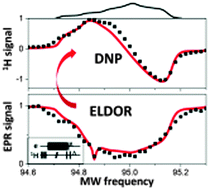Effects of the electron polarization on dynamic nuclear polarization in solids†
Abstract
Dynamic Nuclear Polarization (DNP) experiments on solid dielectrics can be described in terms of the Solid Effect (SE) and Cross Effect (CE) mechanisms. These mechanisms are best understood by following the spin dynamics in electron–nuclear and electron–electron–nuclear model systems, respectively. Recently it was shown that the frequency swept DNP enhancement profiles can be reconstructed by combining basic SE and CE DNP spectra. However, this analysis did not take into account the role of the electron spectral diffusion (eSD), which can result in a dramatic loss of electron polarization along the EPR line. In this paper we extend the analysis of DNP spectra by including the influence of the eSD process on the enhancement profiles. We show for an electron–electron–nuclear model system that the change in nuclear polarization can be caused by direct MW irradiation on the CE electron transitions, resulting in a direct CE (dCE) enhancement, or by the influence of the eSD process on the spin system, resulting in nuclear enhancements via a process we term the indirect CE (iCE). We next derive the dependence of the basic SE, dCE, and iCE DNP spectra on the electron polarization distribution along the EPR line and on the MW irradiation frequency. The electron polarization can be obtained from ELDOR experiments, using a recent model which describes its temporal evolution in real samples. Finally, DNP and ELDOR spectra, recorded for a 40 mM TEMPOL sample at 10–40 K, are analyzed. It is shown that the iCE is the major mechanism responsible for the bulk nuclear enhancement at all temperatures.


 Please wait while we load your content...
Please wait while we load your content...